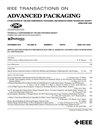Wafer Level Processing of Integrated Passive Components Using Polyimide or Polybenzoxazole/Copper Multilayer Technology
引用次数: 24
Abstract
Focus of this work was the development and optimization of process techniques for the application of Polyimide (PI) or Polybenzoxazole (PBO) to act as dielectric material together with semi-additive copper as conductive material in a thin film multilayer buildup, which is suitable for the integration of all three types of passive components. A thin film set up including seven layers was used to create integrated coils with values between 1 and 80 nH , integrated resistors with values between 100 ¿ and 100 k¿ as well as integrated radio-frequency (RF) filters for application between 2 and 5 GHz. As substrate material both low resistivity silicon and glass (Borofloat 33) was used, which influences the quality factor of the coils as well as the filter performance substantially. The fabricated structures performed well in thermal cycling tests, where no critical failure could be observed after 3000 thermal cycles for all examined components. The RF components have shown no critical deviations between initial measurements and measurements performed after thermal cycling. The resistor values have shown no deviations between the measurements, which have been taken before and after thermal cycling. Thus Polyimide/Polybenzoxazole/copper multilayer wiring represents a reliable and versatile base technology for the fabrication of passive components at wafer level.聚酰亚胺或聚苯并恶唑/铜多层技术的晶圆级集成无源元件加工
本工作的重点是开发和优化聚酰亚胺(PI)或聚苯并恶唑(PBO)作为介电材料与半添加剂铜作为导电材料在薄膜多层结构中的应用工艺技术,该工艺适用于三种类型的无源元件的集成。一个包括七层的薄膜被用来制造值在1到80 nH之间的集成线圈,值在100到100 k之间的集成电阻器,以及应用在2到5 GHz之间的集成射频(RF)滤波器。衬底材料采用了低阻硅和玻璃(Borofloat 33),这对线圈的品质因子和滤波性能都有很大的影响。制造的结构在热循环测试中表现良好,在3000个热循环后,所有被检查的组件都没有观察到临界失效。射频组件在初始测量和热循环后进行的测量之间没有明显的偏差。在热循环之前和之后进行的测量中,电阻器值没有显示出偏差。因此,聚酰亚胺/聚苯并恶唑/铜多层布线代表了在晶圆级制造无源元件的可靠和通用的基础技术。
本文章由计算机程序翻译,如有差异,请以英文原文为准。
求助全文
约1分钟内获得全文
求助全文

 求助内容:
求助内容: 应助结果提醒方式:
应助结果提醒方式:


